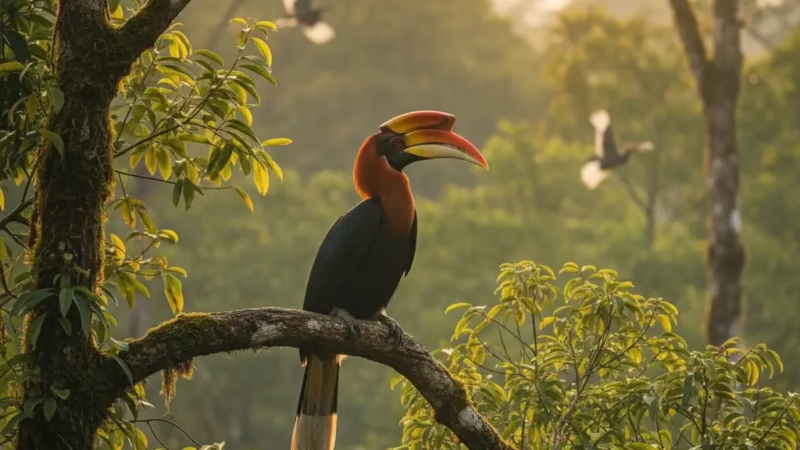How to Spot Hornbills in Sarawak

Introduction
If you’ve ever dreamed of seeing the majestic hornbill soaring through the rainforests, Sarawak is the place to go. Known as the “Land of the Hornbills,” this Malaysian state is home to eight hornbill species, including the iconic Rhinoceros Hornbill. In this guide, you’ll learn how to spot hornbills in their natural habitat—from the best locations and times to visit, to useful birdwatching tips. Whether you’re a nature lover or a first-time visitor, spotting these incredible birds will be a highlight of your Sarawak adventure.
Step 1: Learn About Sarawak’s Hornbills
Before heading into the wild, get familiar with the types of hornbills found in Sarawak. The most common are the Rhinoceros Hornbill, Oriental Pied Hornbill, and Bushy-crested Hornbill. Each has unique features—such as the vibrant casque of the Rhinoceros Hornbill or the smaller frame of the Oriental Pied Hornbill. Knowing these details helps you identify them quickly during your trip.
Tip: Bring a bird guidebook or use an app like Merlin Bird ID for quick identification.
Step 2: Visit the Right Locations
Hornbills thrive in Sarawak’s lush rainforests and national parks. Here are the top spots:
- Bako National Park: Excellent for spotting Oriental Pied and Rhinoceros Hornbills.
- Kubah National Park: Dense forest trails make it a hornbill hotspot.
- Mulu National Park (UNESCO World Heritage Site): Known for sightings of multiple species.
- Semenggoh Nature Reserve: Occasionally visited by wild hornbills.
Tip: Visit parks early in the morning or late in the afternoon, when hornbills are most active.
Step 3: Time Your Visit Right
The best time to spot hornbills in Sarawak is during the dry season (May to September). Birds are more active, and visibility is better. During this period, fruiting trees attract hornbills, making them easier to find.
Pro Tip: Plan your visit around sunrise (6–8 AM) or sunset (5–7 PM) when hornbills are most likely to fly between trees.
Step 4: Bring the Right Gear
You don’t need expensive equipment to start birdwatching, but the right tools make a big difference.
- Binoculars (8x or 10x magnification) – essential for spotting birds at a distance.
- Camera with telephoto lens – for great wildlife photography.
- Lightweight clothing and hat – Sarawak’s tropical weather can be humid and hot.
- Insect repellent and water – comfort is key during long observation hours.
Tip: Use quiet, neutral-colored gear to avoid startling the birds.
Step 5: Learn How to Listen and Watch Quietly
Hornbills are shy and easily startled. Walk slowly, avoid loud noises, and listen for their distinctive whooshing wingbeats or cackling calls. Sometimes you’ll hear them before you see them.
Tip: Stay patient—birdwatching often requires standing still for several minutes.
Step 6: Join a Guided Birdwatching Tour
If you’re new to birdwatching, joining a guided tour is the easiest way to see hornbills. Local guides know nesting areas and feeding trees, increasing your chances of a sighting.
Where to book:
Bonus: You’ll also learn about other native birds like kingfishers and trogons.
Step 7: Support Conservation Efforts
Hornbills play a vital ecological role by dispersing seeds and maintaining forest health. When visiting, follow park rules, avoid littering, and donate to local conservation programs like the Hornbill Research Foundation or Sarawak Forestry Corporation. Responsible tourism ensures these magnificent birds thrive for generations.
FAQs
1. How many hornbill species can be found in Sarawak?
Sarawak is home to eight hornbill species, including the Rhinoceros, Oriental Pied, Wreathed, Black, Bushy-crested, Helmeted, White-crowned, and Wrinkled Hornbills.
2. Can I see hornbills near Kuching city?
Yes, Bako National Park and Kubah National Park are both accessible from Kuching and offer good chances to spot hornbills.
3. Are hornbills endangered?
Some species, like the Helmeted Hornbill, are critically endangered due to habitat loss and poaching. Conservation areas in Sarawak help protect them.
Conclusion
Spotting hornbills in Sarawak is a magical experience that connects you to Borneo’s vibrant wildlife. With patience, the right timing, and respect for nature, you’ll have the chance to witness these majestic birds in their natural home. So grab your binoculars, pack your sense of wonder, and get ready to explore the Land of the Hornbills!















Comments are closed.